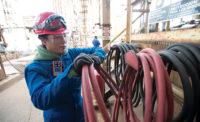 Amid speculation that OSHA is on the verge of issuing a Notice of Proposed Rulemaking (NPRM) to modernize the beryllium standard, worker safety advocates are hoping that it provides stronger protections for construction workers.
Amid speculation that OSHA is on the verge of issuing a Notice of Proposed Rulemaking (NPRM) to modernize the beryllium standard, worker safety advocates are hoping that it provides stronger protections for construction workers.
Public Citizen’s Keith Wrightson said the current standard is inadequate, “especially in the construction industry, where an estimated 23,000 construction workers come in contact with beryllium every day while performing open-air blasting.”
The group petitioned OSHA back in 2001 to lower the personal exposure limit for beryllium from its current threshold of 2.0 μg/m3 (micrograms per cubic meter of air) to 0.2 μg/m3.
On Dec. 6, 2013, the Advisory Committee on Construction Safety and Health heard testimony from OSHA officials and the public on possible changes to the current beryllium standard for general industry (29 C.F.R. 1910.1000) and construction (29 C.F.R. 1926.55). Last month, OSHA presented options for the committee to consider for updating the beryllium standard. One of those options includes lowering the personal exposure limit, as Public Citizen has long recommended, and an identical short-term exposure limit. It also includes better exposure monitoring, broader regulated areas, enhanced medical surveillance and clearer methods of compliance with the standard.
High dust concentrations on construction sites can lead to extremely elevated beryllium levels. OSHA has said that 70 percent of all worksites where abrasive blasting is performed – such as construction sites and ship-building yards – have detectable beryllium levels, with a mean level of 3.7 μg/m3 and a median of 0.6 μg/m3. While some workers who engage in open-air blasting are protected from high dust levels through air respirators and protective clothing supplied by employers, many are still being exposed to the harmful effects of beryllium because employers don’t provide protection.
“After so many years of foot-dragging by OSHA, it is time that the tens of thousands of workers exposed to beryllium on a daily basis get the protections they deserve,” said Wrightson. “We urge the committee to recommend the strongest protections possible within a new beryllium standard.”
